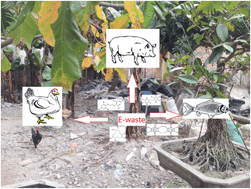Most of the materials we use nowadays are impregnated with several chemicals to make them fireproof and meet fire safety regulations. These are classically halogenated compounds such as polybrominated diphenyl ethers (PBDEs). Recently, the food safety authorities in the EU banned PBDEs because several studies linked them to hepatic damage and perturbations in metabolism.
Hence, chemists developed a new kind of fire retardants known as hexabromocyclododecanes (HBCDs). Manufacturers of goods such as plastics, textiles and electronic equipment, are increasingly using these compounds. However, HBCDs may not be an ideal solution: recent studies found them in dust, air, sediments, and sewage in areas surrounding electronic waste (or e-waste) processing plants. And what is worse, the presence of HBCDs has also been reported in eggs, while researchers have confirmed human exposure from eating food sourced near the e-waste treatment plants. These are concerning issues, since these chemical are potentially toxic, persistent and bioaccumulative.
In this article published in Environmental Science: Processes & Impacts, Dr. Fang Tao and co-workers investigated the presence of HBCDs and other fire retardants in fish, pigs and free-range chickens reared in areas that could have been polluted by e-waste plants in Bui Dau, Vietnam. In addition to this, the team also took samples from supposedly non-contaminated zones both in Vietnam and Japan and analysed them.
The authors reported that HBCDs, as well as other emerging fire retardants, are found in chicken, fish and pork samples collected near the e-waste processing plant in Bui Dau. According to these data, locals may be ingesting dangerous amounts of toxic, accumulative chemicals. Although the dangers of some of these compounds are not completely defined yet, the researchers suggest to keep studying this phenomenon: the quantity of these contaminants in the environment may rise soon.
Interested in this research? Click on the link below to read the full article for free*
Emerging halogenated flame retardants and hexabromocyclododecanes in food samples from an e-waste processing area in Vietnam
Fang Tao, Hidenori Matsukami, Go Suzuki, Nguyen Minh Tue, Pham Hung Viet, Hidetaka Takigami and Stuart Harrad.
Environmental Science: Processes and Impacts, 2016, Advance Article
DOI: 10.1039/C5EM00593K
—————-
Fernando Gomollón-Bel is a PhD Student at the ISQCH (CSIC–University of Zaragoza). His research focuses on asymmetric organic synthesis using sugars as chiral-pool starting materials towards the production of fungical transglycosidase inhibitors.
—————-
* Access is free until 11/04/2016 through a registered RSC account.












